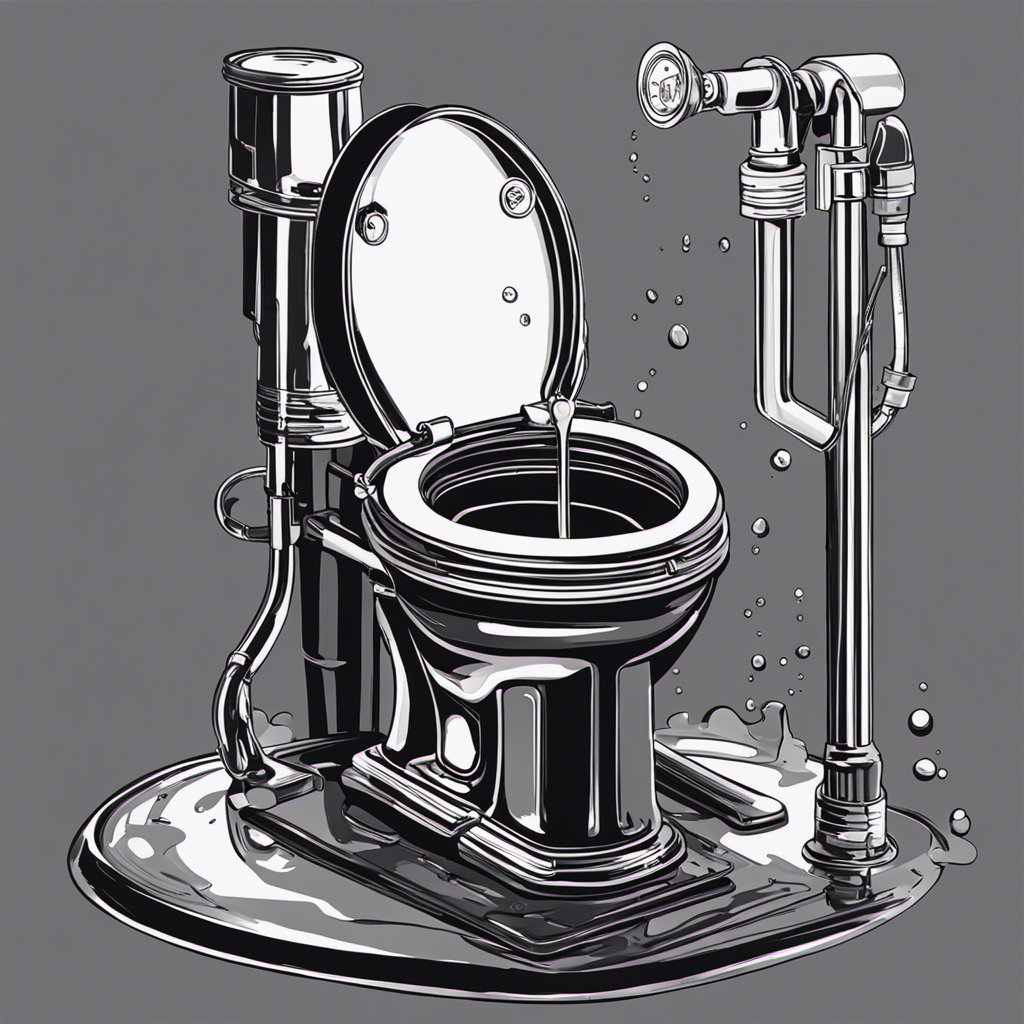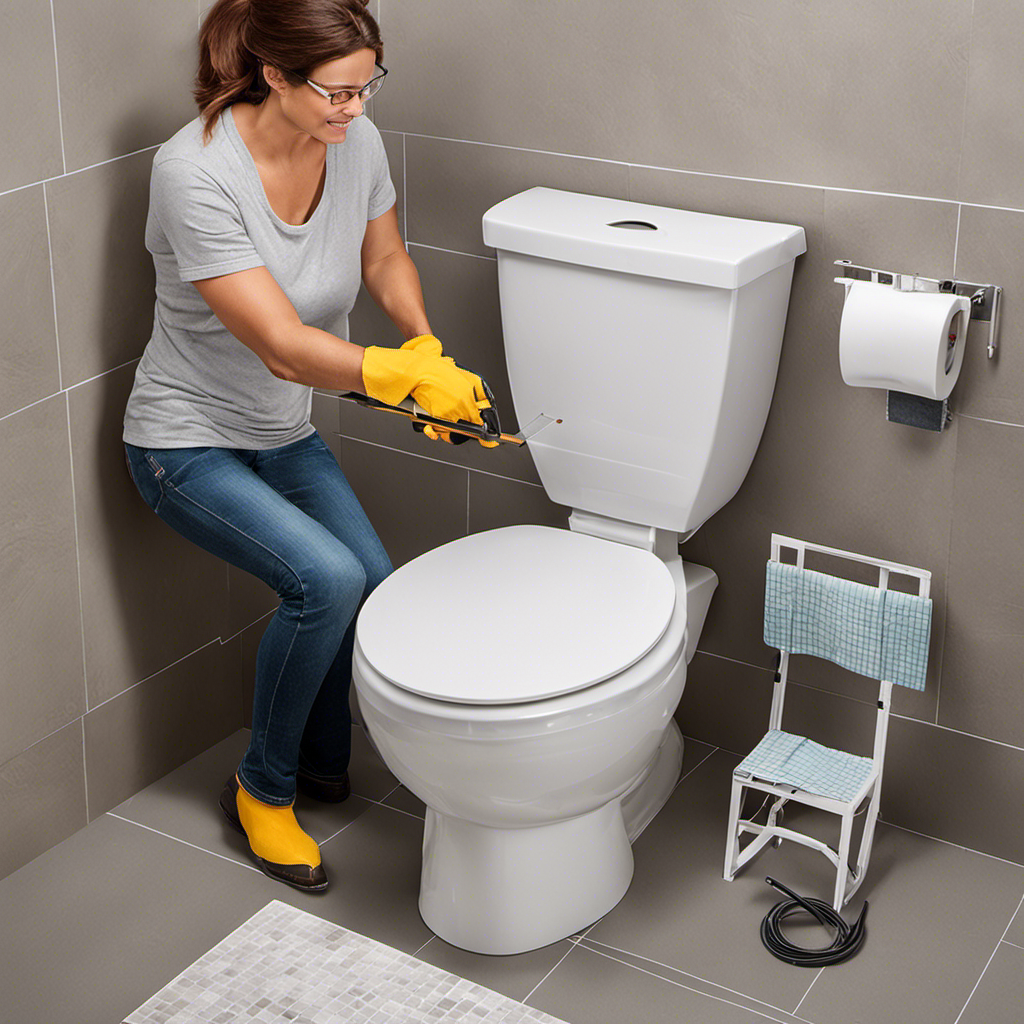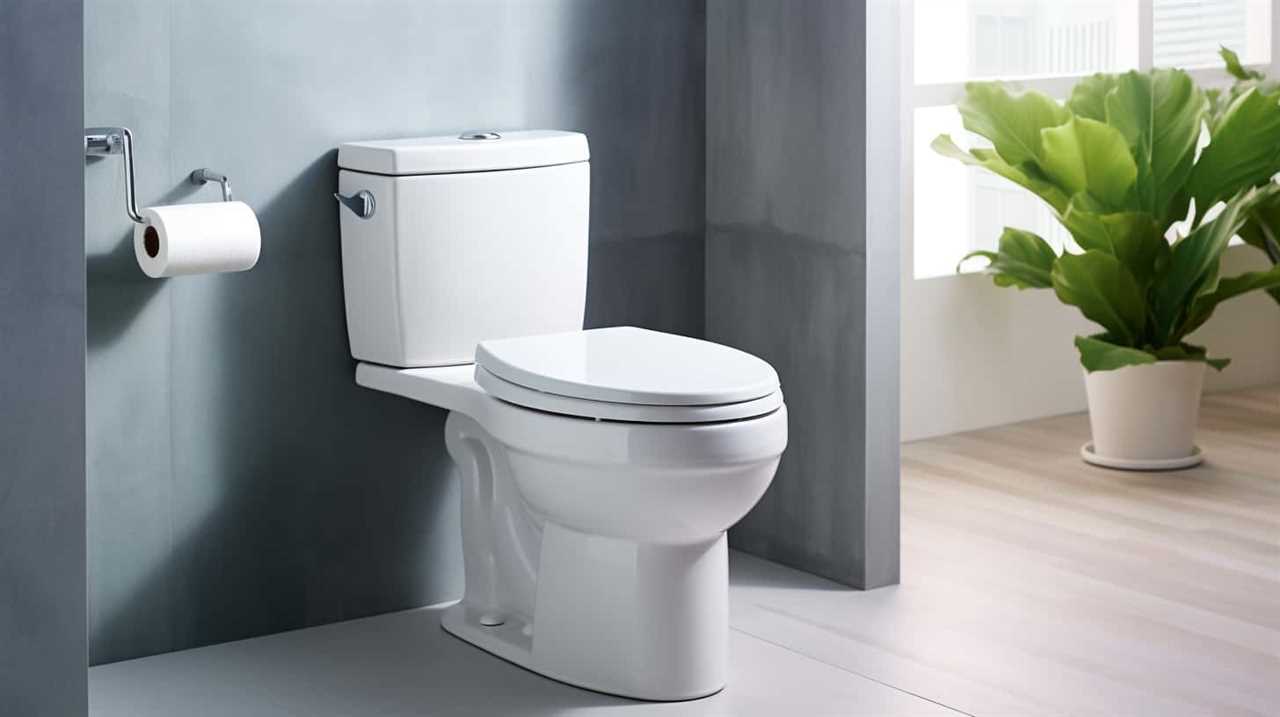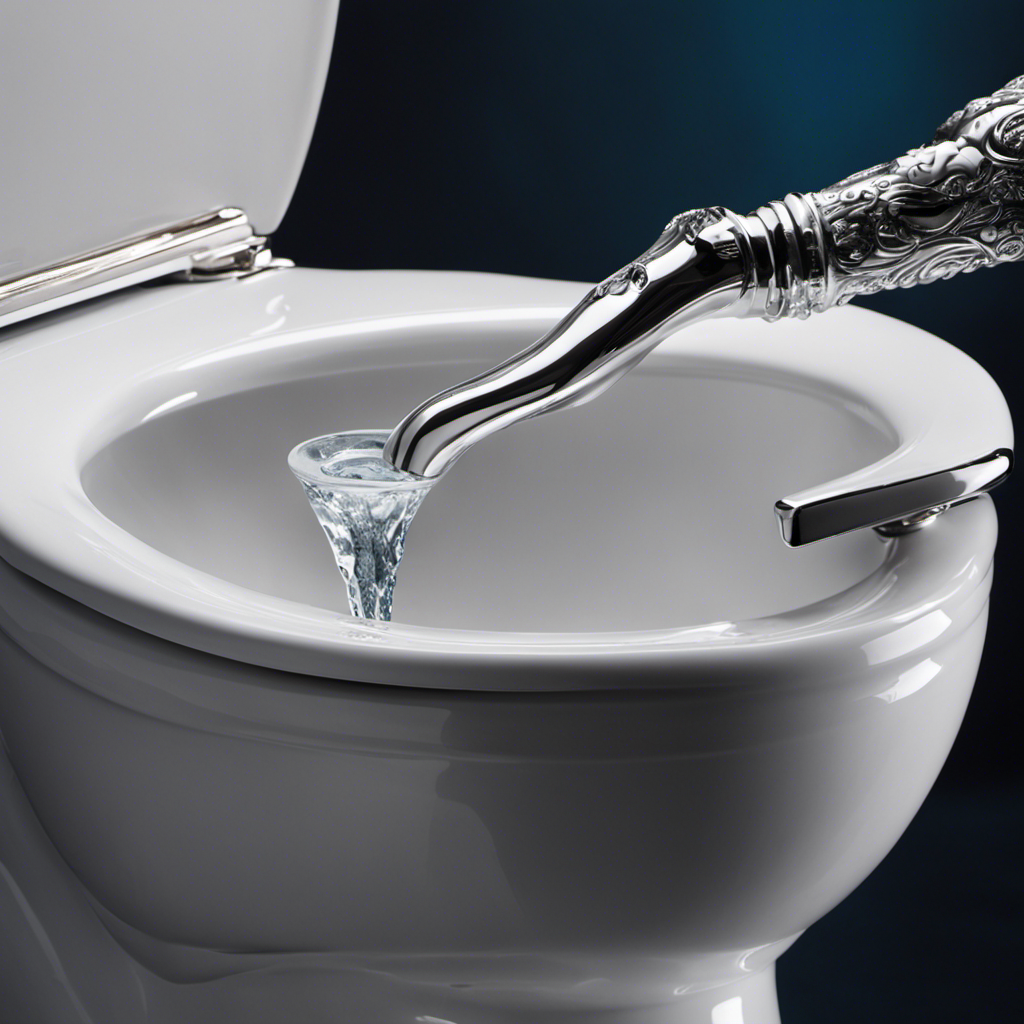Are you dreading the thought of emptying your toilet tank? We get it, it can be a messy and unpleasant task. But fear not! With the right tools and a little know-how, you can tackle this chore like a pro.
In this article, we will guide you step-by-step through the process of emptying your toilet tank. From shutting off the water supply to cleaning the tank thoroughly, we’ve got you covered.
So, let’s get started and make this task a breeze!
Key Takeaways
- Gloves and protective gear are necessary to ensure safety while working on the toilet tank.
- Shut off the water supply using the shut-off valve near the base of the toilet or the main water supply valve for the house.
- Drain the toilet tank by lifting the float valve assembly or ballcock and flushing the toilet.
- Clean the tank thoroughly using proper cleaning techniques and materials to prevent bacterial growth.
Preparing the Necessary Tools
First, you’ll need to gather the tools you’ll need to empty the toilet tank. This step is crucial for toilet tank maintenance and repair.
To start, you’ll require a pair of gloves to protect your hands from any potential mess. Next, grab a large bucket or container to collect the water from the tank. Additionally, having a towel or rag nearby is useful for wiping up any spills.
You’ll also need a pair of pliers to disconnect the water supply line and a wrench to loosen the bolts securing the tank to the bowl. Lastly, it’s a good idea to have a sponge or scrub brush on hand to clean the tank once it’s empty.
With these tools ready, you’ll be well-prepared for the task at hand.
Shutting off the Water Supply
Before you can begin, make sure you shut off the water supply to the toilet. This step is crucial in preventing leaks and ensuring a smooth process.
Follow these steps to troubleshoot the water supply:
-
Locate the shut-off valve: Look for a valve near the base of the toilet, usually on the wall or floor. It should be connected to a water pipe.
-
Turn off the valve: Rotate the valve clockwise to close it. If it’s a lever-style valve, simply flip it to the closed position.
-
If the valve is stuck: Apply some lubricant to loosen it. If that doesn’t work, you may need to call a professional plumber.
-
If there is no shut-off valve: You can turn off the main water supply valve for your house. This valve is usually located near the water meter.
Draining the Toilet Tank
To safely proceed, make sure you drain the water from the toilet tank before continuing.
Draining the toilet tank is an important step in toilet tank maintenance and troubleshooting toilet tank issues.
First, locate the shut-off valve near the base of the toilet and turn it clockwise to stop the water flow.
Next, remove the toilet tank lid and carefully lift the float valve assembly or ballcock to allow the water to drain into the bowl. You can also flush the toilet once to speed up the process.
Once the water has drained, use a sponge or towel to soak up any remaining water in the tank.
Now that you have successfully drained the toilet tank, you can move on to removing excess water from the tank.
Removing Excess Water From the Tank
Once the water has been drained from the tank, you can use a sponge or towel to soak up any remaining water. Make sure to wring out the sponge or towel into a bucket to prevent any water from dripping onto the floor.
After removing the excess water, it’s important to perform regular toilet tank maintenance to keep it in optimal condition and conserve water. Here are some water conservation tips for toilet tank maintenance:
-
Check for leaks: Inspect the toilet tank and bowl for any leaks. A leaking toilet can waste a significant amount of water, so it’s crucial to fix any leaks promptly.
-
Replace faulty parts: If you notice any worn-out or damaged parts, such as the flapper or fill valve, replace them to ensure proper functioning and prevent water wastage.
-
Adjust the water level: Adjust the water level in the tank to the appropriate height. Most toilet tanks have a water level adjustment screw or float that can be easily adjusted to conserve water.
Cleaning the Tank Thoroughly
When it comes to cleaning your tank thoroughly, there are a few key points to keep in mind.
Firstly, you’ll want to familiarize yourself with the proper tank cleaning techniques to ensure a deep and effective clean.
Secondly, it’s important to take measures to prevent bacterial growth in your tank, as this can lead to unpleasant odors and potential health risks.
Lastly, make sure you have all the necessary cleaning supplies on hand, such as brushes, disinfectants, and gloves, to ensure a successful cleaning process.
Tank Cleaning Techniques
There are various techniques you can use to clean the toilet tank. Keeping your toilet tank clean is important for toilet tank maintenance and preventing toilet odors. Here are some effective techniques you can try:
-
Regular cleaning:
-
Use a toilet brush to scrub the inside of the tank, focusing on the walls and bottom.
-
Flush the tank multiple times to remove any debris or residue.
-
Deep cleaning:
-
Turn off the water supply to the toilet tank.
-
Empty the tank by flushing and using a sponge or towel to soak up any remaining water.
-
Mix a solution of equal parts vinegar and water and pour it into the tank.
-
Scrub the tank with a brush, paying attention to hard-to-reach areas.
-
Let the solution sit for a few hours, then flush the tank multiple times to rinse.
Preventing Bacterial Growth
To prevent bacterial growth in your toilet tank, regularly clean and disinfect the inside using a vinegar and water solution.
Bacteria can multiply quickly in warm and moist environments, so it’s important to take steps to prevent contamination.
Here’s how to clean your toilet tank:
-
Turn off the water supply to the toilet and flush it to empty the tank.
-
Mix equal parts vinegar and water in a spray bottle.
-
Spray the solution on the inside walls of the tank and let it sit for a few minutes to kill any bacteria.
-
Use a brush or sponge to scrub away any residue or build-up.
-
Finally, flush the toilet a few times to rinse the tank thoroughly.
Now that you know how to prevent bacterial growth, let’s move on to the necessary cleaning supplies.
Necessary Cleaning Supplies
Now that you understand the importance of preventing bacterial growth in your toilet tank, let’s talk about the necessary cleaning supplies you’ll need to maintain and disinfect it effectively.
Here are the items you should have on hand:
-
Cleaning supplies:
-
Disinfectant cleaner: Look for a toilet-specific disinfectant cleaner that is effective against bacteria and viruses.
-
Toilet brush: This will help you scrub away any dirt or grime that may have built up in the tank.
-
Microfiber cloth: Use this cloth to wipe down the exterior of the tank and any other surfaces that may have come into contact with bacteria.
-
Protective gear:
-
Gloves: Protect your hands from coming into direct contact with any potentially harmful bacteria or chemicals during the cleaning process.
-
Mask: Wearing a mask can help prevent the inhalation of any airborne particles that may be present in the tank.
Refilling and Testing the Toilet Tank
Once you’ve finished refilling the toilet tank, you can go ahead and test it by flushing.
To properly refill the tank, start by turning the water supply valve back on. This will allow water to flow into the tank. As the tank fills, you can adjust the water level by using the water level adjustment screw or float. The water level should be about an inch below the top of the overflow tube.
Once the tank is filled to the desired level, it’s time to test it. Gently press down on the flush handle and observe the flushing action. The water should flow smoothly and efficiently, clearing the bowl completely. If there are any issues, adjust the water level accordingly and test again until it flushes properly.
Conclusion
In conclusion, emptying a toilet tank is a simple task that anyone can do with the right tools and knowledge. By following the steps outlined in this article, you can successfully complete the process and ensure a clean and well-functioning toilet.
Just like emptying a toilet tank, tackling any challenge in life requires preparation, patience, and attention to detail. Remember, sometimes we need to let go of what’s holding us back in order to make room for new opportunities.
So, go ahead and empty that tank, and let the fresh water of progress flow into your life.










